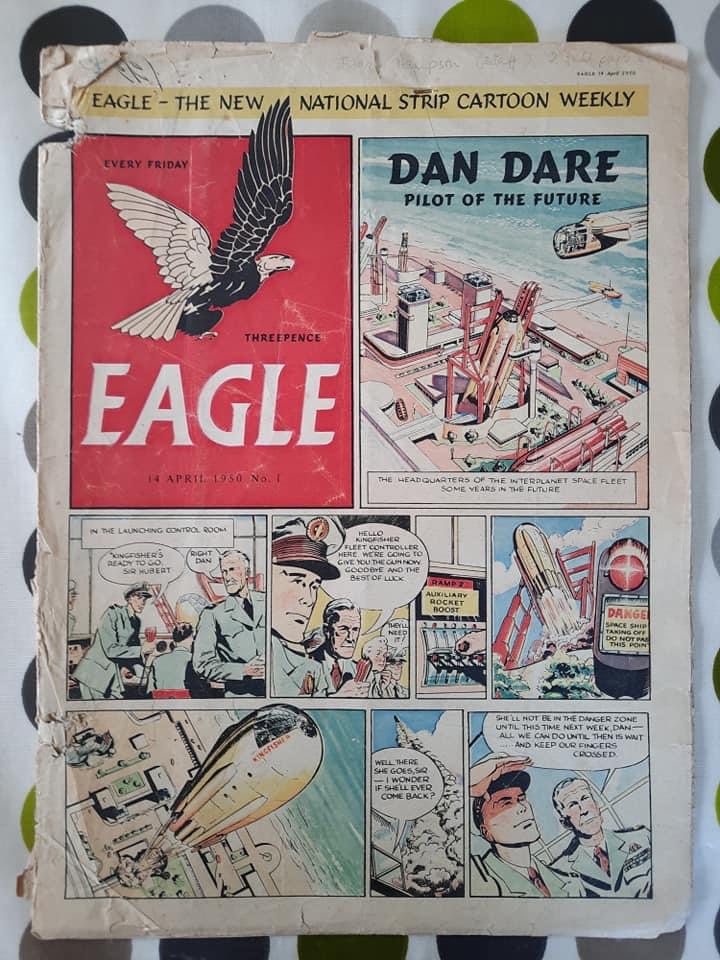
A rare “pay copy” of the first issue of Eagle comic reveals the freelance and agency editorial costs of creating the landmark launch issue British weekly was just over £360.
The comic, cover dated 14th April 1950, published by Hulton Press, brought us Dan Dare and much more – and, crammed with colour strips and features as it was, the title had a lasting impact on those that bought it. Its influence on comic creators continues to this day, even though it was published in the 1950s.
The “pay copy” details an editorial cost of £360 (plus 18 shillings and eight pence) to secure the services of cutaway artist Leslie Ashwell Wood, John Ryan (the creator of “Captain Pugwash”), Norman Thelwell (“Chicko”) may not sound a lot now, but the Bank of England’s own Inflation Calculator reveals that’s over £12,600, based on 2020 rates of inflation, averaged 5.2% a year.
“I still can’t believe I won this!”enthuses owner Willoughby Hurrell, who runs The Comic Collector vintage comic service. “It’s brilliant!
“It details the names of artists and script writers that worked on the issue, as well as how much they were paid.”
The costs as detailed only cover freelancer and agency payments. The cost of creating “Dan Dare” himself isn’t specifically included in any obvious way, but Frank Hampson is instead listed as a “staff artist”.
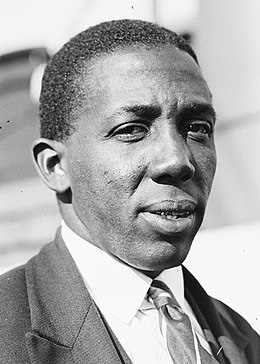
It includes, for example, the cost of West Indian cricketer Learie Constantine’s sports feature, credited as “Leary Constantine” – £10, about £350 today.
The contributor list also confirms the elusive creators of the European strip “Skippy the Kangaroo” (not to be confused with the eponymous TV show) as Danet, Dubrisay, and Genêstre, but, sadly, there’s no indication of source, presumed to be a translated reprint.
Missing from the contributors costs is any mention of “Tommy Walls”, because that was an advertorial, paid for by Walls, not Hulton.
Battered though it might be, Willoughby tells us the condition of the strip areas is remarkably good.
“I’ve been comparing it to my ‘normal’ first issue, and the covers on this are much sharper than the ordinary one,” he says.
“It’s not in the greatest shape, but its significance is so huge I don’t care that much.
“I previously didn’t know of any Hulton publishers file copies for their first issues, but this confirms that Eagle had one. Now all I need to find is file copies for Girl, Robin and Swift!”
Eagle No.1 — 14th April 1950
Contributors (in some cases, names as documented, those mis-spelt corrected with thanks to David Slinn and others)
Dan Dare (Pages 1-2) – Comic Strip
Art — Frank Hampson
Story — Frank Hampson
Note Hampson gets sole credit
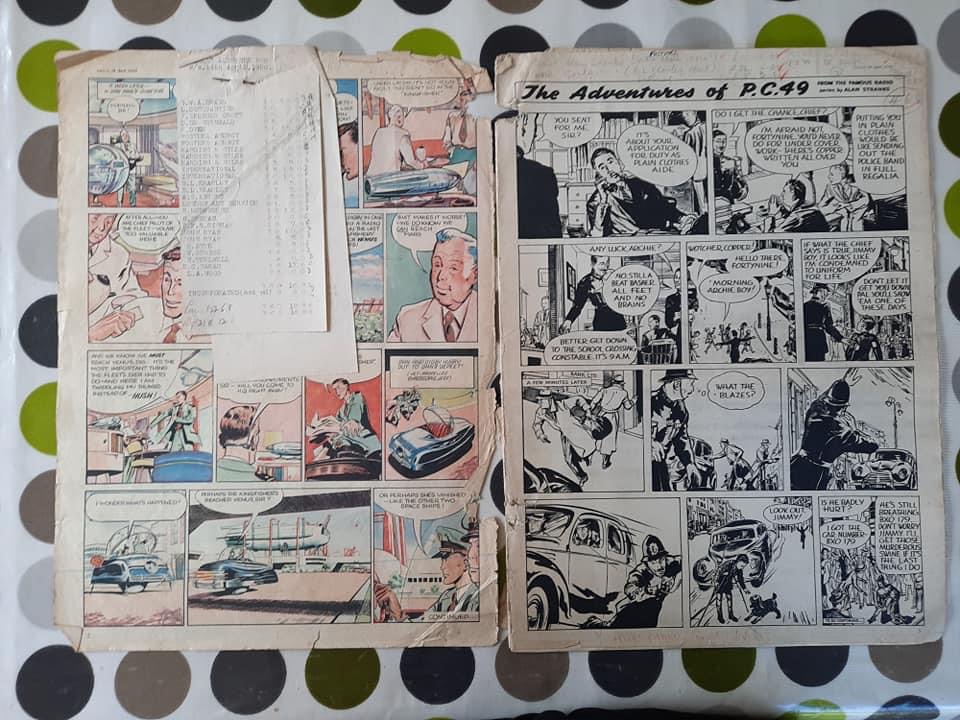
The Adventures of P.C. 49 (Page 3) – Comic Strip
Art — Gould
Story — Alan Stranks
Created by Alan Stranks, P.C. 49 began as a radio series character. The Adventures of P.C. 49 first aired as part of the BBC’s Light Programme on 27th October 1947, with Brian Reece playing the title role. The character’s popularity grew rapidly, and he was adapted for comics by Stranks to debut in that format in the first issue of Eagle. Initially, Strom Gould illustrated the tales, but was replaced in August 1951 by John Worsley, who would continue to draw the strip until its demise in March 1957. The character also appeared in several annuals and a couple of reprint volumes.
Plot Against the World (Pages 4-5) – Text Story
Art — Oliphant
Story — Chad Varah
Steve Holland notes Alexander (George) Oliphant was a Scottish artist, who also contributed to Eagle Annual, the Daily Mirror Book for Boys, and was the artist who illustrated “Sea Change” in Ranger in 1965-66
Edward Chad Varah CH CBE was a British Anglican priest and social activist from England. In 1953, he founded the Samaritans, the world’s first crisis hotline, to provide telephone support to those contemplating suicide. He supplemented his clerical income by working as a scriptwriter for Eagle and its sister publications Girl, Robin and i until 1961. He used his scientific education to be “Scientific and Astronautical Consultant” (as Varah put it) to “Dan Dare”
Captain Pugwash (Page 5) – Comic Strip
Art — John Ryan
Story — John Ryan
John Ryan created Captain Pugwash as a comic strip for Eagle, but the strip was dropped after three months as it was felt to be aimed at younger readers than the target audience. Unperturbed, he created “Harris Tweed, Special Agent” which replaced “Rob Conway”. However, when The Radio Times commissioned him to provide a strip he resurrected “Captain Pugwash”. In 1957, he was commissioned by the BBC to produce a series of animation shorts featuring the character, originally running from 1957 to 1958.
Cricket Coaching (Page 6) – Comic Strip
Art — W. Alford
Story — Learie Constantine (credited as Leary Constantine)
Artist David Slinn reminds us it was Denis Alford, not “W. Alford”, handling the Eagle’s two initial sports features, through agents Harding & Giles
Learie Constantine played 18 Test matches before World War Two, and took the West Indies’ first wicket in Test cricket. He became a lawyer just a few years after writing his Eagle features, then a politician, and served as Trinidad and Tobago’s High Commissioner to the United Kingdom and became the UK’s first black peer. An advocate against racial discrimination, in later life he was influential in the passing of the 1965 Race Relations Act in Britain. He was knighted in 1962 and made a life peer in 1969.
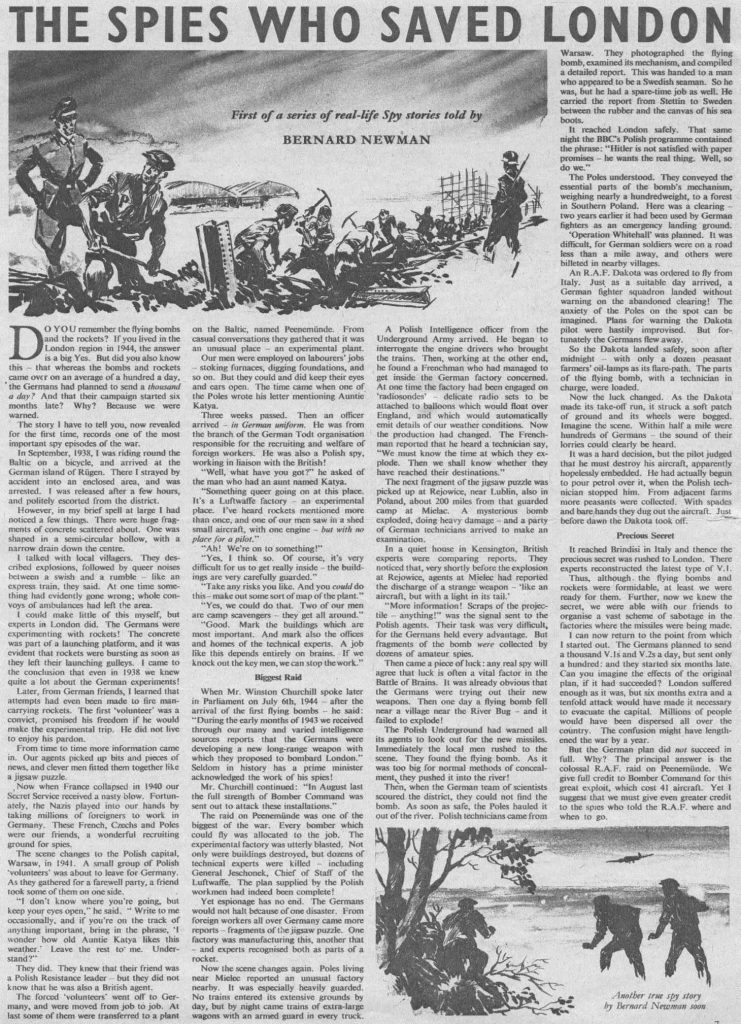
The Spies Who Saved London (Page 7) – Text Story
Art — Arthur Horowicz
Story — Bernard Newman
International Artists represented writer Arthur Horowicz.
Bernard Newman was an espionage expert who would contribute numerous text series of real life spy stories to Eagle
Professor Brittain Explains: (Page 8) – Comic Strip
Art — J. Spencer Croft
Story — J. Spencer Croft
Seth and Shorty — Cowboys (Page 9) – Comic Strip
Art — John Harris
Story — John Harris
The western adventure “Seth and Shorty” lasted seventeen weeks, replaced by a strip relating the “Life of Cortez, Conqueror of Mexico”, written by Ronald Syme and drawn by William Stobbs, who also created the “Real Life Mysteries” strip. That, in turn, was replaced by Charles Chilton’s “Riders of the Range”.
The art is very variable throughout this Eagle Western strip’s run, and John Harris is later associated with some rather indifferent text story illustrations for the title.
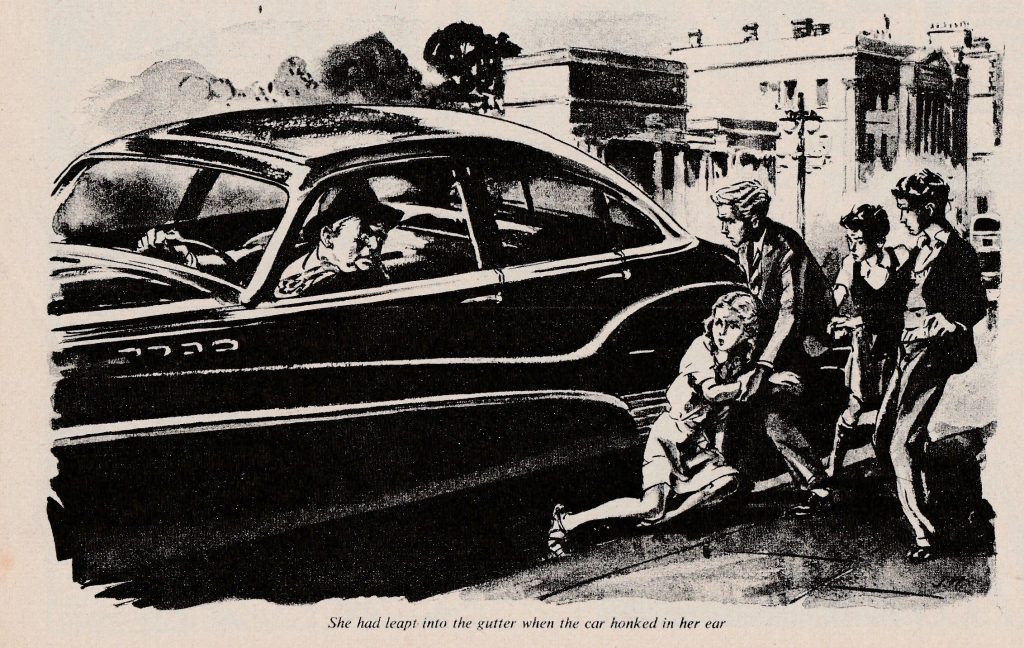
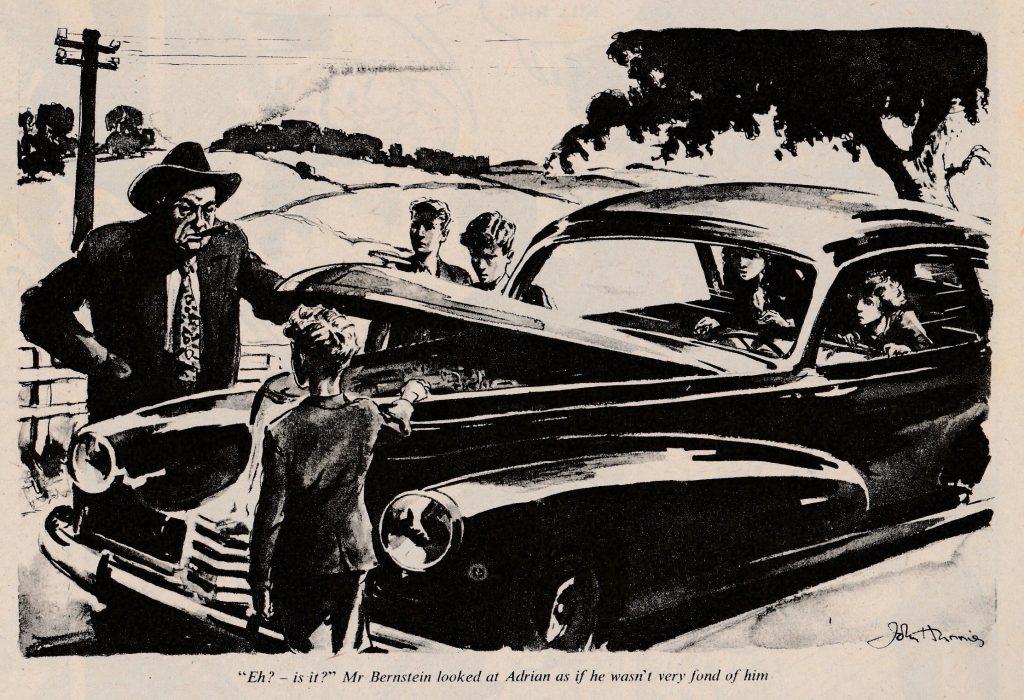
That the strip was drawn by Harris has proven something of a revelation, identification eluding some longtime Eagle fans, including David Slinn, for decades. However, when compared with Harris illustration work, such as those for a later Eagle serial, “The Scarlet Snuffbox”, this explains why it’s taken seventy years to twig the connection.
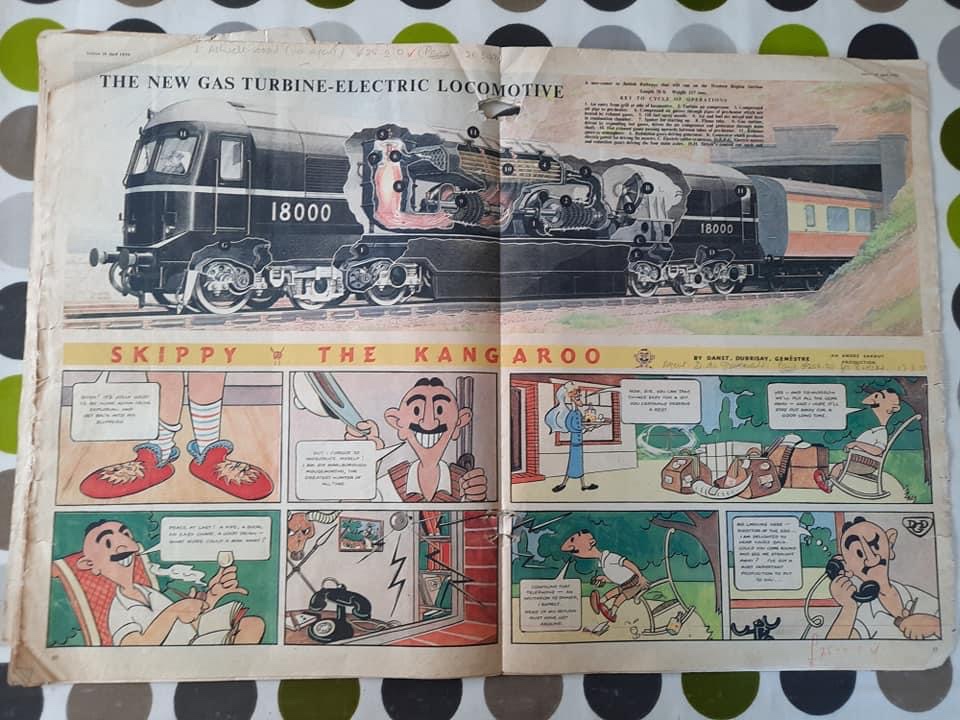
The New Gas Turbine – Electric Locomotive (Pages 10 — 11) – Cutaway
Art — L. Ashwell—Wood
Story — L. Ashwell—Wood
Artist Leslie Ashwell Wood was paid £25 (£876) for his cutaway for the issue, but we know that cost rose fairly quickly thanks to information on other Eagle file copies. By 1954, he was getting paid £42 (1,176) for the same size and style.
Skippy the Kangaroo (Pages 10 — 11) – Comic Strip
Art — Danet, Dubrisay, Genêstre
Story — Danet, Dubrisay, Genêstre
See our separate “Skippy the Kangaroo” feature
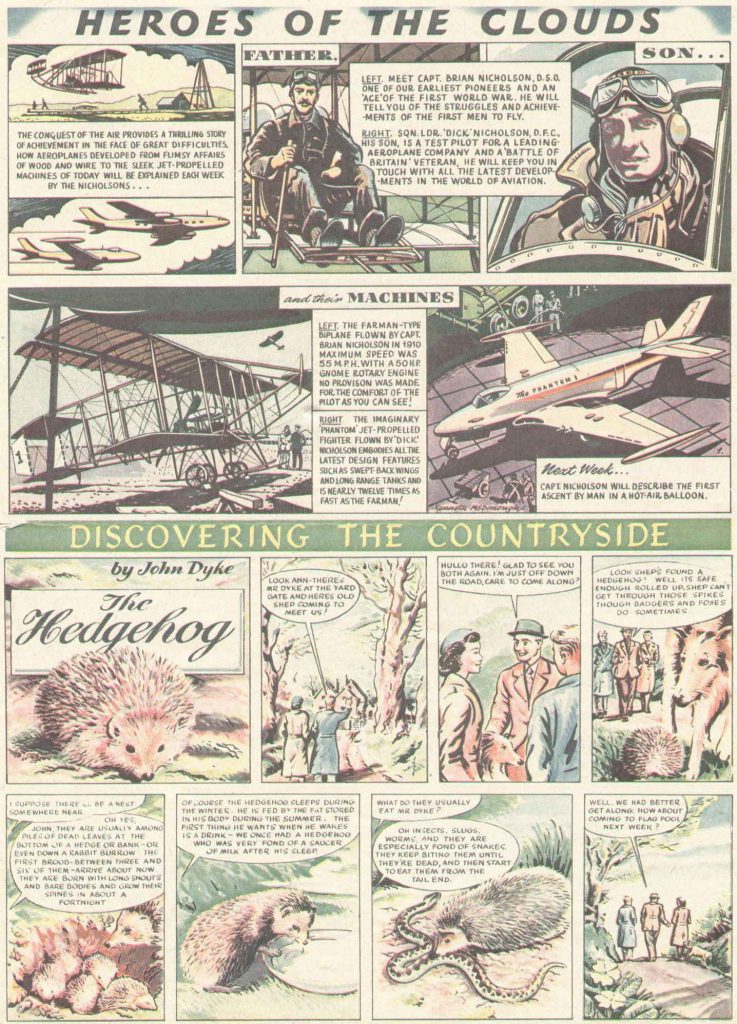
Heroes of the Clouds (Page 12) – Comic Strip
Art — Kenneth McDonough
Story — Kenneth McDonough
Discovering the Countryside (Page 12) – Comic Strip
Art — John Dyke
Story — John Dyke
Real Life Mysteries (Page 13) – Comic Strip
Art — William Stobbs
Story — Ronald Syme
Making Your Own Model Racing Car (Page 14) – Comic Strip
Art — G.W. Ashton Brand
Story — G.W. Ashton Brand
Sporting Personalities (Page 14) – Feature
Art — W. Alford
Story — W. Alford
As above, it was Denis Alford, not “W. Alford”, handling the Eagle’s two initial sports features, through agents Harding & Giles
The Eagle Club and Editors Page (Page 15) – Feature
Art — John Ryan
Story — Marcus Morris
Chicko (Page 15) – Comic Strip
Art — Thelwell
Story — Thelwell
This three frame strip is the first regular work of Norman Thelwell, going by his surname only. “Chicko” was drawn while the cartoonist had a full-time job teaching illustration and design at Wolverhampton College
Lash Lonergan’s Quest (Page 16-17) – Text Story
Art — Arthur Horowicz
Story — Moore Raymond

Rob Conway (Page 18) – Comic Strip
Art — Harold Johns
Story — Harold Johns
A product of the Hampson studio, intriguingly, Martin Crookall has previously noted it is Frank Hampson who signs the art in the first three weeks of this rather mundane strip, with assistant Harold Johns credited for the next three, after which all credits disappear.
The strip lasted just 17 weeks, replaced by John Ryan’s “Harris Tweed, Extra Special Agent”
The Great Adventurer (Page 20) – Comic Strip
Art — Frank Hampson
Story — Frank Hampson
Also on downthetubes…
• The Eagle at 66: A Boy’s Eye View
Published in 2016, this article by artist David Slinn explains the enormous impact the Eagle made on its debut in April 1950. Not least later on, leading to his own career in publishing; initially, as a freelance lettering artist on Eagle and its companion papers, while eventually contributing illustrations to the Hulton Press titles and other children’s publications
• Whatever Happened to Eagle’s “Skippy the Kangaroo”?
Not to be confused with the TV show of the 1960s (or its associated comics), “Skippy the Kangaroo” was an odd little humour strip that ran in the first volume of Eagle, and has been dismissed by some fans of the comic as something of a disappointment, its creators something of a mystery to comic fans.
Notes on the editorial costs of publishing SMASH Issue 8, cover dated 26th March 1966
WEB LINKS
• Check out items on offer from The Comic Collector here on eBay
As The Comic Collector, Willoughby Hurrell specialises in vintage British comics, from the obvious Beano, Dandy and 2000AD to the lesser known Bullet, Nutty and Magic. Offering a range of British comic items on a regular basis, the company will do deals on some items, and they are interested in buying all pre-millennium comics and comic related ephemera, single issues or complete collections.
• Find The Comic Collector on Facebook
• Eagle – Volume 1 (1950/51) – by Martin Crookall
• Eagle Volume One No.1 – UK Comic Database, University of Bournemouth
With thanks to to Willoughby Hurrell for sharing details of his purchase, Jeremy Briggs, Richard Sheaf and David Slinn
The founder of downthetubes, which he established in 1998. John works as a comics and magazine editor, writer, and on promotional work for the Lakes International Comic Art Festival. He is currently editor of Star Trek Explorer, published by Titan – his third tour of duty on the title originally titled Star Trek Magazine.
Working in British comics publishing since the 1980s, his credits include editor of titles such as Doctor Who Magazine, Babylon 5 Magazine, and more. He also edited the comics anthology STRIP Magazine and edited several audio comics for ROK Comics. He has also edited several comic collections, including volumes of “Charley’s War” and “Dan Dare”.
He’s the writer of “Pilgrim: Secrets and Lies” for B7 Comics; “Crucible”, a creator-owned project with 2000AD artist Smuzz; and “Death Duty” and “Skow Dogs” with Dave Hailwood.
Categories: British Comics, Classic British Comics, downthetubes Comics News, downthetubes News
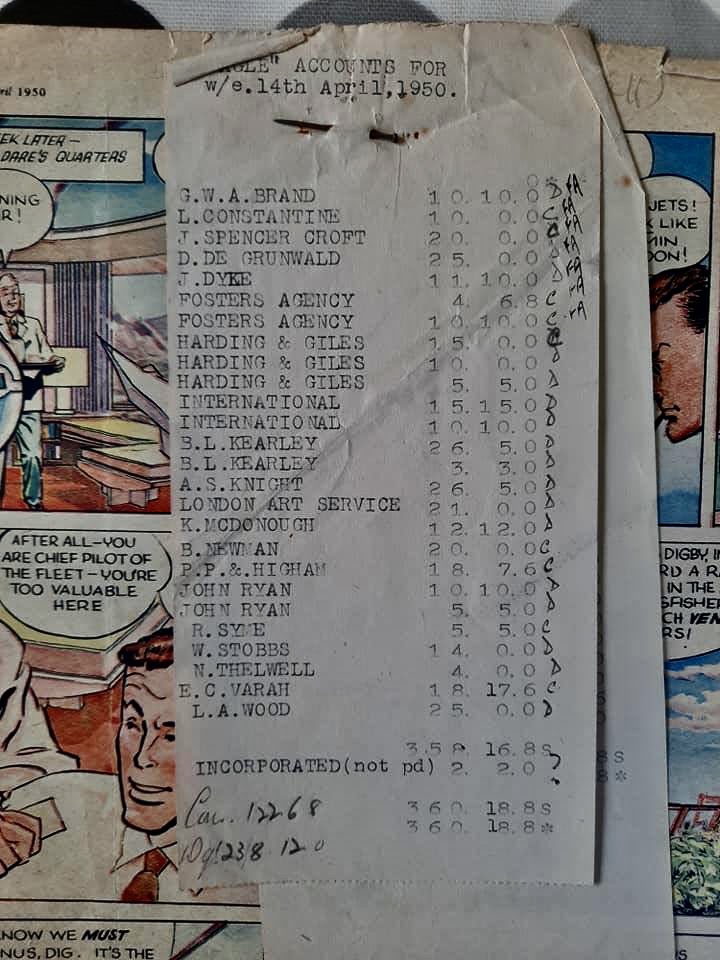
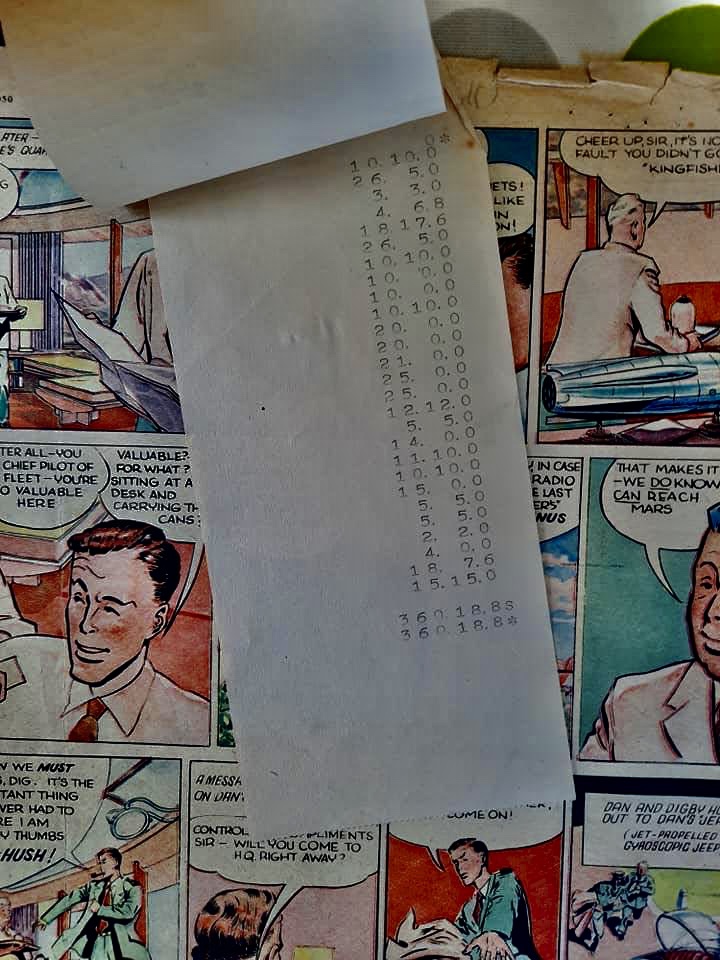
 New Eagle Times spotlights pioneering female comic artist Lily Renée
New Eagle Times spotlights pioneering female comic artist Lily Renée  “Starhawk” in the spotlight in latest Spaceship Away
“Starhawk” in the spotlight in latest Spaceship Away  Comics of yesteryear marked, both launches and endings, including New Eagle
Comics of yesteryear marked, both launches and endings, including New Eagle  Latest EAGLE Times spotlights Classics Illustrated, an American Dan Dare, and more
Latest EAGLE Times spotlights Classics Illustrated, an American Dan Dare, and more
I was an early subscriber to Eagle. Those early editions pressed just the right buttons. They appealed to the same audience as Johns’s Biggles and Worrals books: Adults, juveniles, males females, could all enjoy it without a blush. But it lost its way. Dan Dare was typical of the decline. Pimply adolescent space cadets were introduced. Why? Male readers of all ages identified with Dan; female readers with Professor Jocelyn Peabody. Oddly, there were no female space cadets. Worse was to come: cuddly alien animals. I can’t have been alone in feeling distinctly uneasy when PC 49 – brilliantly drawn by John Worsley notwithstanding – ditched his radio girl friend Joan Carr to run an all-male youth club. After Frank Hampson was taken ill midway through Operation Saturn, and the Dan Dare strip declined into silliness (fencing matches with humanoid aliens, for example), I gave up and cancelled. If only Eagle had stuck to its original brief!